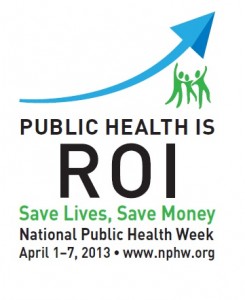Workplace Health Is Public Health
Posted on by It’s National Public Health Week. Those of us who work in workplace safety and health know that workplace health is an integral part of public health. While “Creating a Healthy Workplace” is one of the five themes of National Public Health Week, the role of workplace health in Public Health is not always clear to the general public. If you were asked to make the case for or provide examples of the importance of workplace safety and health in the broader context of public health, what would you say? We would like to hear how you explain to your colleagues, friends, and family that workplace safety and health IS public health.
It’s National Public Health Week. Those of us who work in workplace safety and health know that workplace health is an integral part of public health. While “Creating a Healthy Workplace” is one of the five themes of National Public Health Week, the role of workplace health in Public Health is not always clear to the general public. If you were asked to make the case for or provide examples of the importance of workplace safety and health in the broader context of public health, what would you say? We would like to hear how you explain to your colleagues, friends, and family that workplace safety and health IS public health.
Here are some ideas to get you started.
- Many of us spend a significant portion of our lives at work. In 2011, 65 percent of the population worked full time and year roundi.
- Many hazards or exposures that concern the general population are seen first and in much higher concentrations in the workplace. For example:
- Hazards related to butter flavoring chemical mixtures, including diacetyl, that have been associated with severe obstructive work-related lung disease popularly know as “popcorn lung” were first identified in the workplace.
- Health implications related to nanomaterials are being researched in the workplace. This research will help make these innovative materials safer for the workers who produce and use them and in turn safer for the general public.
- Overexposure to lead remains a leading cause of workplace illness.ii Workers can also expose their families unintentionally if they track lead home on their skin, clothing, or equipment.
- Increasingly, health professionals, employers, and workers see the interactive value of combining workplace health protection with workplace-based health promotion—what we call Total Worker Health™.
- Based on medical costs and productivity losses, in 2007, the cost of work-related fatalities and nonfatal injuries and illnesses was estimated at approximately $263 billion in 2010 dollars.iii This amount exceeds the individual cost of cancer, coronary heart disease, stroke, and diabetes.
- Everyone deserves a healthy and safe workplace
- In 2011, 4,609 U.S. workers died from work-related injuries.iv
- Employers reported approximately 3 million injuries and illnesses to workers in private industry and 820,900 in state and local government in 2011.v In the same year, approximately 2.9 million workers were treated in emergency departments and 150,000 were hospitalized (CDC, unpublished data, 2013).
- Fatal occupational illnesses are not tracked comprehensively by national surveillance systems so the total must be estimated. In 2007 there were an estimated 53,445 deaths from occupational illness.iii
Please share your thoughts below and feel free to use any of this information as you make the case for workplace safety and health.
Frank Hearl, PE
Mr. Hearl is the NIOSH Economics Program Manager and the Chief of Staff in the NIOSH Office of the Director.
i. WORK EXPERIENCE OF THE POPULATION – 2011 http://www.bls.gov/news.release/work.nr0.htm
ii. http://www.osha.gov/SLTC/lead/
iii. http://www.cdc.gov/niosh/programs/econ/risks.html
iv. Bureau of Labor Statistics, US Department of Labor. Economic news release: table 2. Fatal occupational injuries by industry and selected event or exposure, 2011 (preliminary). Washington, DC: US Department of Labor, Bureau of Labor Statistics; 2012. Available at http://bls.gov/news.release/cfoi.t02.htm. Accessed March 18 , 2013.
v. Bureau of Labor Statistics, US Department of Labor. Economic news release: workplace injury and illness summary. Washington, DC: US Department of Labor, Bureau of Labor Statistics; 2012. Available at http://www.bls.gov/news.release/osh.nr0.htm.
Accessed March 18 , 2013.
Posted on by

